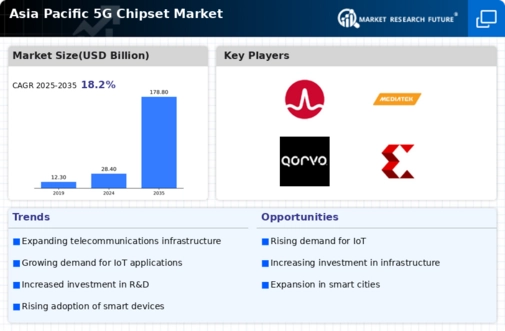Increasing deployment of IoT devices requiring advanced 5G chipsets is driving market growth
The Asia Pacific 5G Chipset market CAGR is expanding due to the surging deployment of Internet of Things (IoT) devices. These chipsets provide rapid data transmission, reduced latency, and improved connection, which are essential for powering many IoT applications in smart cities, healthcare, manufacturing, and agriculture. The 5G Chipset market has grown significantly, with leading manufacturers stepping up their R&D efforts to produce cutting-edge solutions for the developing IoT ecosystem. Furthermore, the deployment of 5G technology is not confined to consumer devices but includes industrial and corporate applications, driving up demand for high-performance chipsets.
As the IoT ecosystem evolves and integrates with 5G networks, the market for sophisticated 5G chipsets is predicted to increase steadily, providing significant potential for innovation and development.
Furthermore, the emergence of smart cities and Industry 4.0 programs has generated a great need for reliable 5G infrastructure. 5G chipsets play an important role in allowing high-speed, low-latency communication networks, which are required for the smooth functioning of smart city systems and the adoption of Industry 4.0 technologies such as automation, robotics, and IoT integration. This need has resulted in phenomenal investment and development into powerful 5G chipsets capable of fulfilling the demanding requirements of these applications.
The 5G Chipset market has expanded rapidly, with leading semiconductor industry companies focused on providing cutting-edge solutions customized to the unique requirements of smart cities and Industry 4.0 applications. These chipsets have been designed to provide great performance, energy economy, and reliability, allowing 5G-enabled products to reach their full potential in urban and industrial contexts. As smart city efforts and Industry 4.0 deployments are created globally, the need for novel 5G chipsets is projected to stay high, pushing additional industry improvements and driving the 5G Chipset market revenue.














Leave a Comment